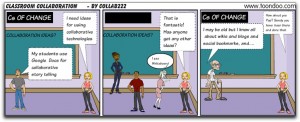Posts tagged online
A Tuition-Free Higher Education School Opens for Enrollment
0 A new online university I’ve been involved with for several weeks just opened for enrollment. Based out of Palm Springs, California, World Education University is a for-profit, tuition-free, online school. It was founded on the belief that everyone in the world should have access to higher education without cost, bypassing socioeconomic barriers that would normally prevent people from engaging in important learning opportunities, and elevate them into higher-class lifestyles. It joins the company of other free online learning communities like Coursera, edX, Udacity, and the University of the People, who offer Massive Open Online Courses (MOOCs). However, there’s an important difference between World Education University (WEU) and other learning communities: WEU is set up as a standalone institution, and has been awarded degree-granting status by the state of California. And they are restlessly pursuing fulfillment of accreditation requirements. So instead of partnering with different colleges that offer college credit for MOOCs, like the University of Antioch has done with Coursera or Colorado State has done with Udacity, everything will happen in-house.
A new online university I’ve been involved with for several weeks just opened for enrollment. Based out of Palm Springs, California, World Education University is a for-profit, tuition-free, online school. It was founded on the belief that everyone in the world should have access to higher education without cost, bypassing socioeconomic barriers that would normally prevent people from engaging in important learning opportunities, and elevate them into higher-class lifestyles. It joins the company of other free online learning communities like Coursera, edX, Udacity, and the University of the People, who offer Massive Open Online Courses (MOOCs). However, there’s an important difference between World Education University (WEU) and other learning communities: WEU is set up as a standalone institution, and has been awarded degree-granting status by the state of California. And they are restlessly pursuing fulfillment of accreditation requirements. So instead of partnering with different colleges that offer college credit for MOOCs, like the University of Antioch has done with Coursera or Colorado State has done with Udacity, everything will happen in-house.
While the structure is probably most similar to University of the People, WEU is taking the for-profit route, instead of non-profit. Tuition costs are subsidized through advertising and forming business partnerships, rather than through donors. Every student will have a marketing profile. Very few people would ever claim to like ads, but sitting through a few ads and an occasional marketing survey in exchange for a college degree? Who wouldn’t do that?
I’m optimistic. With the recent news that 40 more public universities started offering college credits for free MOOCs, I think the time is right for an endeavor like this. There’s a few obstacles WEU is aggressively striving to overcome so it can sustain itself as a valid and effective institution of higher learning in the long run.
Instructor Involvement and Peer-to-Peer Learning
In a MOOC I participated in recently, one person noted, “A MOOC is very illustrative of what self-directed learners can do. There is, very purposefully, I believe, little intrusion from a teacher in the traditional sense as the participants start to create their own meaning. In this way new knowledge on the given topic evolves.” I love the peer-to-peer approach to learning. It encourages socialization and collaboration, deeply involves students in the educational process, and empowers students to take control of their own learning. An online environment is especially suited for peer-to-peer learning, because it tends to level the playing field. Educators have noted before that shy students tend to open up to their teachers and classmates in an online class, and say things and voice thoughts they’d never have the initiative to communicate in a face-to-face situation.
 Students can’t be left in the dark. There must be a structure, and typically in an online learning environment an instructor or facilitator assumes that role. However, in a MOOC, this can be a little trickier. To help address this, WEU is implementing an adaptive learning system which facilitates educational experiences unique to the individual’s learning styles. And if WEU can successfully emphasize the best aspects of its peer-to-peer approach to learning, it will really soar in the quality of its learning material and how its students engage the courseware and their classmates.
Students can’t be left in the dark. There must be a structure, and typically in an online learning environment an instructor or facilitator assumes that role. However, in a MOOC, this can be a little trickier. To help address this, WEU is implementing an adaptive learning system which facilitates educational experiences unique to the individual’s learning styles. And if WEU can successfully emphasize the best aspects of its peer-to-peer approach to learning, it will really soar in the quality of its learning material and how its students engage the courseware and their classmates.
Validity of Degrees
Certainly, it is a prime time to implement a higher-ed business model like WEU. The economy is still recovering, unemployment rates are high in many areas, and college tuition rates are continuing to rise faster than inflation. People recognize the need for marketable knowledge and skills a college setting can provide, but it’s not within everyone’s grasp financially. The attraction of zero-cost education is growing, as evidenced by the constant rise in MOOCs, and the attention they’ve received from accredited universities.
But how attractive will this be to students? I can understand why it’s hard for some to rationalize spending time on a course for which they don’t receive a tangible benefit, such as a raise or an industry-recognized diploma. In the U.S., accreditation is especially a big deal. For example, according to the course catalog, WEU is offering a Masters in K-8 Instructional Mathematics. Many K-12 schools and districts offer raises, tuition reimbursement, and added recognition for teachers who complete extra degrees. But if it’s not accredited, teachers may not receive these benefits.
However, this is not always the case overseas, especially in developing countries. In a place like Thailand or Malaysia, a degree from an American college is valuable no matter the accreditation status. Such a degree is evidence the graduate is knowledgeable and fluent in English…both highly marketable skills in such an area. WEU will undoubtedly be extremely attractive to students from countries with a lower socioeconomic status.
Fortunately, WEU has a full-time staff actively working on fulfilling the requirements for accreditation. As soon as they make more headway in this area — and I’m confident it’s just a matter of time — you can bet I’m going to enroll in a degree program, but that’s not stopping me from participating in a few other classes as a non-credit student for my own edification and personal enhancement.
I highly recommend visiting World Education University’s web site to learn more about this unique school, its mission, goals, and the courses it offers.
Related articles

E-Learning Courseware Tools
1An online classroom offers more provisions to use web-based tools than a face-to-face classroom might. For Weber Online, we are using the Utah Electronic High School’s (EHS) curriculum, but our plan is to “update” it to model better practices, and Web 2.0, which have gotten increasingly sophisticated, will undoubtedly play an important role in this. Modern students, both young and old, thrive with richly interactive web tools, especially as the next generations will be increasingly comfortable and familiar with interactive web-based environments.
Udutu
Udutu is a courseware development tool that allows the teacher to make non-linear Flash-based lessons with multimedia, quizzes, and activities. The lessons are far more visually appealing than simply reading a giant page of textual information, which is how EHS courses are currently set up. Thought-provoking activities such as roleplays are ideal for Udutu lessons. What’s more, you can import Flash (SWF) files into the course you develop, which opens up numerous possibilities to integrate Udutu with other Web 2.0 tools, and existing materials on the web.
For example, typing “photosynthesis filetype:swf” will yield a number of Flash animations that could be imported for a lesson on plants, such as http://dendro.cnre.vt.edu/forestbiology/photosynthesis.swf Searching for “nuclear fission filetype:swf” yields a number of good animations on nuclear fission, such as http://www.british-energy.com/swf/fission.swf. Before importing anything, it is a good idea to make sure you’re not running afoul of copyright and fair use restrictions, and make sure you include a link to the source.
Animoto
If you have a segment of your lesson that’s heavy on photos or short videos, you can use Animoto to create an eye-catching musical video with interspersed text, and add this to a Udutu page. It only takes a few minutes to design a video with Animoto, though you may have to wait awhile for it to fully render it. Make sure you sign up with Animoto for Education to take advantage of the special longer videos they offer to teachers, for free.
ToonDoo
 ToonDoo is a comic strip creator. Students may respond to instructional material better when a virtual character is guiding and co-learning the material with them (Spierling, 2005). ToonDoo allows you to place virtual characters in scenes, arrange relevant props around them, then use captions to share instructional content. Due to the limited-text nature of comics, these shouldn’t be used as the primary tool in delivering instructional material, but to emphasize key points of lessons conveyed through other more conventional means, such as text, audio, etc.
ToonDoo is a comic strip creator. Students may respond to instructional material better when a virtual character is guiding and co-learning the material with them (Spierling, 2005). ToonDoo allows you to place virtual characters in scenes, arrange relevant props around them, then use captions to share instructional content. Due to the limited-text nature of comics, these shouldn’t be used as the primary tool in delivering instructional material, but to emphasize key points of lessons conveyed through other more conventional means, such as text, audio, etc.
References
Spierling, U. (2005). Beyond virtual tutors: Semi-autonomous characters as learning companions. ACM SIGGRAPH 2005 Educators program, SIGGRAPH ’05. Los Angeles, California: ACM.
Five Challenges to Online Education
1We are gearing up to launch Weber Online, our school district’s new web site for fully online courses. We’ve been using Moodle as a hybrid learning environment in our junior and high schools for a few years now, and the online courses will use the same system. With the assistance of a counselor, Weber School District students will be able to register for courses such as Fitness for Life, Physics, Biology, Earth Science, Anatomy, and more to accelerate their learning process, and possibly graduate early.
This is a new frontier for Weber School District, and there will be some hurdles to overcome. Few, if any of our teachers have direct experience with teaching in a fully online environment. Watson (2007) identifies five major challenges that schools and districts often encounter when implementing online courses.
Many parents, administrators, educators, and legislators do not fully understand online education
In 2006, Michigan became the first state in the U.S. to mandate virtual K-12 learning, requiring that each student take at least one online course before graduation. Others states followed in the years after. With Utah Senate Bill 65, a statewide online education network was ratified, yet the community is still somewhat divided on the issue.
 Generally people see anything that can aid a student’s education as a positive thing, but the problem is that people often don’t understand the ramifications of online learning. Is it really that different from a traditional classroom? How does a student communicate with the teacher? Some people think online learning constitutes a “teacher-less” or “self-directed” learning environment. Recent changes to Utah’s law has K-12 students registering for online courses in “windows” of enrollment each semester, rather than an anytime free-for-all, suggesting that a progressive model of learning in the collaborative social environment similar to a traditional classroom can be used. As Dawley (2007) demonstrated, online group learning gives students a stronger sense of community, instills enthusiasm and motivation with coursework, addresses multiple learning styles, reduces feelings of isolation, and gives opportunities to gain experience in using teamwork in testing real-world practices, a critical trait for functioning in the modern workplace (p. 98).
Generally people see anything that can aid a student’s education as a positive thing, but the problem is that people often don’t understand the ramifications of online learning. Is it really that different from a traditional classroom? How does a student communicate with the teacher? Some people think online learning constitutes a “teacher-less” or “self-directed” learning environment. Recent changes to Utah’s law has K-12 students registering for online courses in “windows” of enrollment each semester, rather than an anytime free-for-all, suggesting that a progressive model of learning in the collaborative social environment similar to a traditional classroom can be used. As Dawley (2007) demonstrated, online group learning gives students a stronger sense of community, instills enthusiasm and motivation with coursework, addresses multiple learning styles, reduces feelings of isolation, and gives opportunities to gain experience in using teamwork in testing real-world practices, a critical trait for functioning in the modern workplace (p. 98).
The problem is that teachers transitioning to online instruction are often at a loss in how they must shift their pedagogy. How do we assess learning? Should we just give quizzes to our students the same way we do in traditional classrooms? Studies suggest that students do perform better with online tests, rather than paper tests (MacCann, 2006). But just because Moodle provides the ability to give online quizzes, shouldn’t lead teachers to believe they are a necessary component of online assessment (Dawley, 2007). “Authentic assessments such as projects and portfolios help students develop real world skills and empower them to take responsibility for their own learning” (Dawley, 2007, p. 174). Online courses have a tendency to thrust students into the position of being more responsible for their own learning anyway.

Current growth trends indicate that 50 percent of all courses in grades 9-12 will be taken online by 2019.
The growth in online education has outpaced education policy and processes
How do we regulate what students are doing online? It has been a long-standing policy of Weber School District that official student-produced work on the Internet must have a teacher backing it. For example, students can’t upload their own videos to WeberTube. A teacher must do it for them. Likewise, can an online teacher request that students produce an online public portfolio as part of their coursework, or must all course materials be kept within the LMS? I’ve written before about student blogging (Why Teachers Should Encourage Students to Blog), but I left out this problematic policy. In Weber School District, teachers are on their own if they want to use Edublogs or a similar system to set up student blogs, but as district policy we discourage anything that in which student work is published without a teacher approving it first. A teacher could set up a fully-moderated blog that meets all these requirements, but this would be using third-party tools, so they’d receive no official support from the district.
And what happens when students outside our district start enrolling in our classes? What jurisdiction do we have over them? How will they integrate with our student system, which was initially designed for in-district students only? How will our online reporting data synchronize with other districts? Questions such as these must be addressed as we move forward.
 Funding for online students and programs has not been resolved
Funding for online students and programs has not been resolvedIt costs money to educate our students. If students start taking one or two extra courses each semester than we originally allotted for them, how will we reconcile this when we carefully analyzed the funding and distribution of assets in our district? How much is the state going to “chip in” to resolve this discrepancy, and will it be enough?
Equal access remains a challenge
Not every family in Weber School District has a computer, let alone high-speed Internet access. While the digital divide is constantly closing, teachers must be aware of some of the challenges. Weber School District does a great job of providing technology and computer lab resources to all its students, but if a student is trying to take an online course from home on a dial-up connection, it hardly makes sense for the teacher to incorporate video lectures and material, as these would take a frustratingly long time to download. Teachers wishing to include multimedia in their courses should survey their students before the course starts to make sure technology gaps don’t exist.
Determining the proper role of technology in education
Technology is only as good as the students and teachers using it. Our students are being trained to be productive, effective members of the community in the 21st century world. Workplace skills require adeptness with technology tools, and our “digital natives” are already intimately familiar with many of the tools. The role of the teacher should be to educate these students in how to use these tools to create stimulating learning experiences, and how they can impact how the students function and perform in real-world situations.
References
Dawley, L. (2007). The tools for successful online teaching. IGI Global.
MacCann, R. (2006). The equivalence of online and traditional testing for different subpopulations
and item types. British Journal of Educational Technology, 37(1), 79-91.
Watson, J. (2007). A national primer on K–12 online learning. Washington, DC: North
American Council on Online Learning.
Improving Our Self-Directed Professional Development in Moodle
0 Moodle has become the primary vehicle of our online learning opportunities. Our Inservice portal was moved off the outdated Moodle server to the newer one that is currently used by teachers and students as an online classroom management tool. The district will be piloting its first entirely online course for K-12 students in the near future, but we do have a number of self-directed courses available. Instructional topics consist of things like using AESOP (our online leave reporter), MyStudent (our administrative desktop application), the Video Portal for playing licensed videos (only accessible inside the district), and others. The content in most of these courses are divided into multiple sections (Beginner, Intermediate, and Advanced). Participants typically watch one or more videos showing the features of the tool, after which they must pass a quiz with an 80% or greater score. If they pass, they receive a printable certificate recognizing their completion of the course, and earn certification points that can be used toward CACTUS re-licensure credit.
Moodle has become the primary vehicle of our online learning opportunities. Our Inservice portal was moved off the outdated Moodle server to the newer one that is currently used by teachers and students as an online classroom management tool. The district will be piloting its first entirely online course for K-12 students in the near future, but we do have a number of self-directed courses available. Instructional topics consist of things like using AESOP (our online leave reporter), MyStudent (our administrative desktop application), the Video Portal for playing licensed videos (only accessible inside the district), and others. The content in most of these courses are divided into multiple sections (Beginner, Intermediate, and Advanced). Participants typically watch one or more videos showing the features of the tool, after which they must pass a quiz with an 80% or greater score. If they pass, they receive a printable certificate recognizing their completion of the course, and earn certification points that can be used toward CACTUS re-licensure credit.
We also use Moodle to deliver the annual instruction, required for all district employees, on Blood Borne Pathogens, hazardous materials in the workplace, and the district’s policy on harassment and discrimination. Moodle will continue to be the chosen means to deliver these forms of online professional development.
However, I think we can do better. I question the effectiveness of these self-directed courses, for a few reasons:
- There is no measurement of preexisting skills and knowledge to use as a baseline, to evaluate learning.
- The short 10-question assessment accompanying each course’s section does not properly measure the effectiveness of the courses. Users are free to retake the quiz as many times as they need to get it right. There is no penalty for retaking the quiz.
- We have no data on the impact of these courses. In fact, from personal experience I can vouch that many of the participants who passed some of these courses, are later stumped on very basic aspects of the tools in question. An adequate instructional program should minimize these instances. But more importantly, we should be able to assess how many people are experiencing these post-training difficulties.
- Some of the courses haven’t been revised in over 3 years.
Without proper assessment, a self-directed course isn’t much different than just posting the tutorials on WeberTube. There is value to self-directed learning, but we need to take a more active role in evaluating these courses. Participants need to be given the chance to put their knowledge into practice. Follow-up surveys could be conducted to determine if the training impacted their behavior 1 month, 3 months, or even 6 months down the road. And revisions to the courses should be frequent and consistent with the data gathered.





